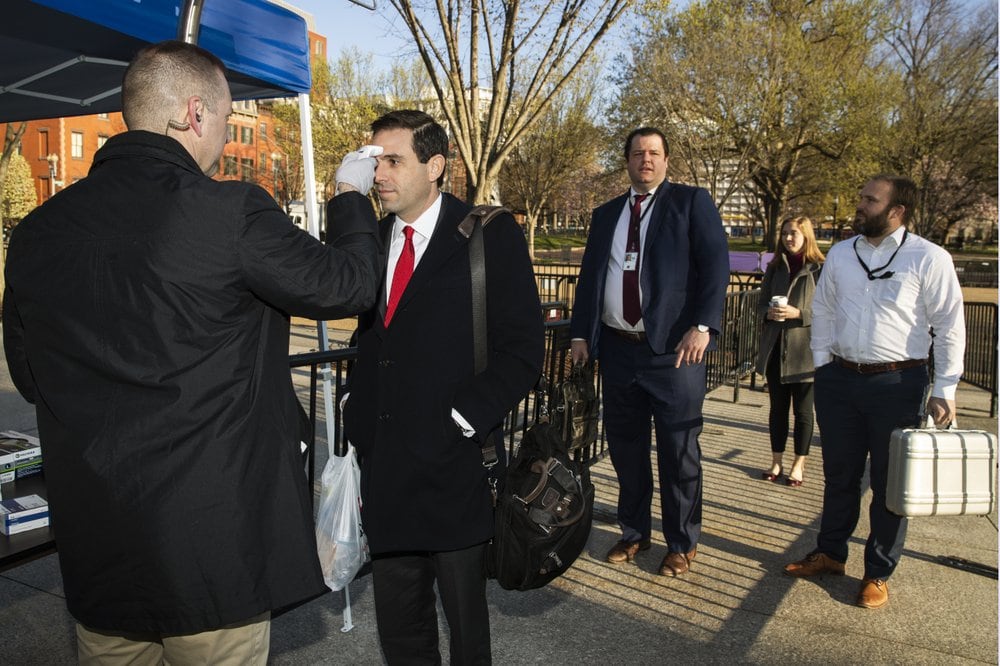
The White House put in place new measures Monday to protect President Donald Trump and his staff during the coronavirus outbreak, including taking the temperature of anyone who enters the complex, such as visitors and members of the press corps.
The steps expanded on screenings the White House began on Saturday for anyone who gets close to Trump and Vice President Mike Pence, who is leading the administration’s response to the virus.
Officials greeted staff, reporters and camera workers by swiping their foreheads with a temporal thermometer. Only those with a reading of 99.6 degrees Fahrenheit (37.6 degrees Celsius) or less were allowed entry into the complex.
“In order to keep the entire White House complex safe and healthy, beginning Monday morning, temperature checks will be conducted on everyone who enters campus,” spokesman Judd Deere said.
The average body temperature is about 98.6 degrees Fahrenheit (37 degrees Celsius), but it can range from a little lower to a little higher. The Centers for Disease Control and Prevention says it considers a person to have a fever when he or she has a temperature of 100.4 degrees Fahrenheit (38 degrees Celsius) or higher.
Inside the James S. Brady Press Briefing Room, an orange sign taped to the back of many seats let reporters know that it was to remain unoccupied during briefings to ensure social distancing. The White House Correspondents’ Association called on all members to stay home or work remotely if they could do so and to keep a bare level of staffing at the White House.
“We understand these restrictions are deeply disruptive to our members and their ability to do their jobs. But we are forced to take these steps to do our part to ensure that there is a healthy pool available to cover the president and inform the public during this critical time,” the association’s board said in an overnight email to members.
The White House on Saturday began taking the temperature of reporters attending a coronavirus briefing led by Trump and Pence. One reporter with a temperature above 100.4 degrees Fahrenheit was denied entry to the briefing room. Temperature checks were conducted before Sunday’s briefing, too.
Trump has had contact with people who later tested positive for the coronavirus, including the press aide for Brazil’s president, but Trump initially refused to be tested.
On Saturday, Trump said he had taken the test in response to questions at a Friday news conference. The White House doctor reported late Saturday that the test came back negative. Trump, 73, would be considered at risk because of his age.
For most people, the new coronavirus causes only mild or moderate symptoms, such as fever and cough. For some, especially older adults and people with existing health problems, it can cause more severe illness, including pneumonia. The vast majority of people recover from the virus.
Other precautionary steps the White House is taking: pausing its internship and volunteer programs, canceling public tours and canceling large events through the end of March. The White House also has closed its Navy Mess Dining Room, where many staffers get daily meals.
The White House also has encouraged staffers to follow guidelines for telework issued by the Office of Management and Budget.
To limit the number of journalists in the briefing room, television networks agreed to pool camera coverage so that just one crew would cover the briefings and share footage with all the other networks, instead of having multiple crews covering the same event.
That system was in place for Sunday’s coronavirus briefing.
“This is an important first step for us, but we all agree more action is needed to protect our members and the integrity of the press pool covering the president,” the White House Correspondents’ Association board said.
___
Republished with permission from the Associated Press.



